Manifestations of psoriasis on the face are rare and atypical. Its main danger is not physiological but psychological. A person faced with such a course of the disease often withdraws, has difficulty communicating and is at risk of falling into a state of severe depression. Meanwhile, the problem can be resolved by achieving stable long-term remission. The main thing is to promptly consult a specialist and not self-medicate.
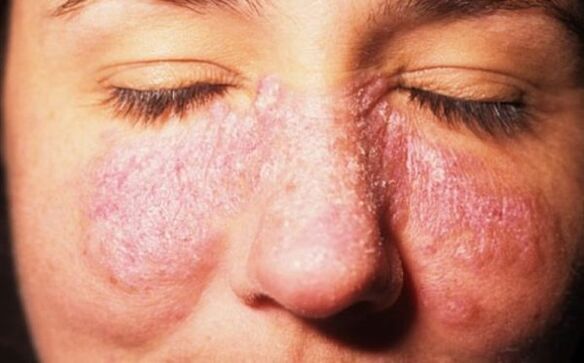
What is psoriasis?
Psoriasis is a chronic, non-contagious disease accompanied by very unpleasant symptoms, including red rashes and peeling of damaged skin areas.
They arise due to disruptions in the dermis replacement mechanism. In healthy people, this process takes an average of 30 days; in sick people, the skin will be renewed in less than a week. The body perceives the rapid formation of new cells as a powerful invasion and mounts an immune response, "sending" increased numbers of white and red blood cells to the site of possible damage, causinginflammation.
More often, a rash characteristic of the disease forms on the elbows and knees, armpits and on the head under the hair. In a few cases, the disease spreads to the face. Scientists are still understanding the cause and mechanism of the disease.
Causes of psoriasis and risk factors
In the scientific community, there has been much debate about the nature of psoriasis for decades. Three hypotheses about the appearance of the disease are the most widely spread:
- autoimmune;
- Endocrine;
- mentality.
In recent years, genetic explanations for the appearance of psoriasis have become popular. This is confirmed by statistics, according to which the majority of patients have relatives with this disease.
Proponents of different theories agree on three points:
- the pluralistic nature of psoriasis, that is, the origin of the pathology is due to many reasons;
- non-communicable diseases;
- stable remission can be achieved.
Doctors have also identified the main factors causing the disease. Among them:
- chronic inflammation;
- severe damage to the skin;
- metabolic disorder;
- severe poisoning;
- weak immunity;
- constant stress;
- freezing;
- Infectious Diseases;
- Alcoholism;
- certain medications (such as beta blockers and antibiotics).
People whose bodies are affected by more than two factors on the list above are most at risk. It is likely that they will encounter the most unpleasant and atypical form of the disease.
Mechanism of appearance of psoriasis on the face
Psoriasis on the face is characterized by rapid development due to particularly sensitive skin. It occurs in different ways, but doctors distinguish three general stages:
- progressive;
- freeze;
- are regressing.
In the final stage, psoriasis symptoms fade and disappear completely. The entire process, depending on the severity and type of disease, takes from two months to six months.
The classification of psoriasis is complex and involves many types. Based on the type of progression, two large groups are conventionally distinguished: pustular (with a rash in the form of pustules) and without pustules. According to severity, lesion area and intensity of manifestation, psoriasis can be mild or severe. Severe forms of psoriasis, characterized by facial, seborrheic secretions, do not fall into the general classification.
Attention! A dangerous complication of this form of the disease is fungal infection of the sebaceous glands.
Symptoms of various types of psoriasis are clearly visible, which allows a competent doctor to accurately diagnose the disease and prescribe adequate treatment.
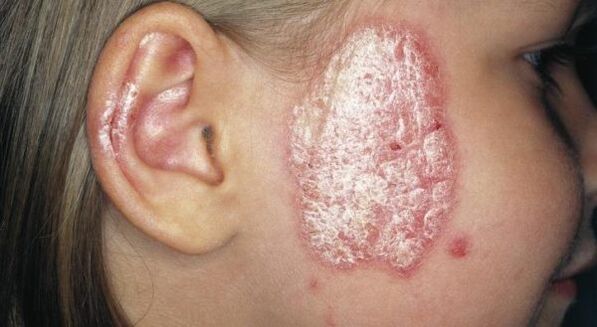
Symptoms of psoriasis on the face
Signs of the early stages of the disease can easily be confused with symptoms of allergy or irritation. Moreover, they appear on the face during the period when the skin is most vulnerable - in the autumn-winter period. Psoriasis may be suspected based on the following symptoms:
- redness on the skin;
- appearance of dandruff;
- itchy;
- small ulcers;
- peel; peel;
- yellow crust formation.
The first spots are no larger than the head of a pin and appear on the forehead and cheeks. Then they grow and fuse together, turning into very itchy red papules.
Attention! Scratching the rash will speed up the spread of papules, which can leave scars.
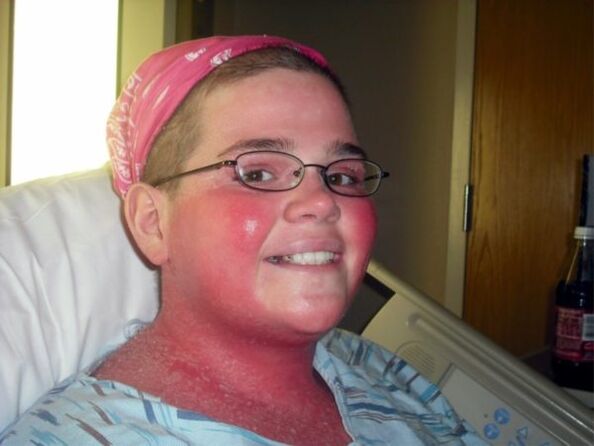
Gradually, papules cover larger and larger areas of skin and form on the lips, nose, ears, and scalp. The plaque begins to bleed when pressed, the scales stick together due to sebum secretion, forming a dense yellow crust. The epidermis becomes thinner and loses the ability to perform its protective function against external influences. It is better to start treatment at the early stages of the disease. Only a dermatologist can determine the severity and type of the disease.
Differential diagnosis
Establishing the correct diagnosis is not difficult for a competent specialist. It is based on data about symptoms and disease progression, as well as visual inspection. The so-called psoriasis triad, detected during scraping of the problem area, has great diagnostic value. It includes three phenomena:
- stearin stains (increased peeling after shaving);
- terminal membrane - a smooth surface in place of the scales that have been removed;
- blood mist - the appearance of drops of blood.
Psoriasis sometimes looks like other diseases. Differential diagnosis is often performed with pathologies such as:
- Syphilis;
- some types of lichen;
- Pityriasis;
- chronic dermatitis;
- eczema;
- parapsoriasis.
To clarify the diagnosis in controversial cases, the following is prescribed:
- allergy testing;
- biochemical blood test;
- histological examination of the skin;
- UAC;
- stool testing for dysbiosis;
- Supersonic;
- X-ray (to rule out psoriatic arthritis).
Unfortunately, upon discovering the first signs of psoriasis on the face, many patients begin to self-medicate, which only aggravates the situation. Meanwhile, modern medicine offers enough tools and techniques so that you can forget about an unpleasant disease for a long time.
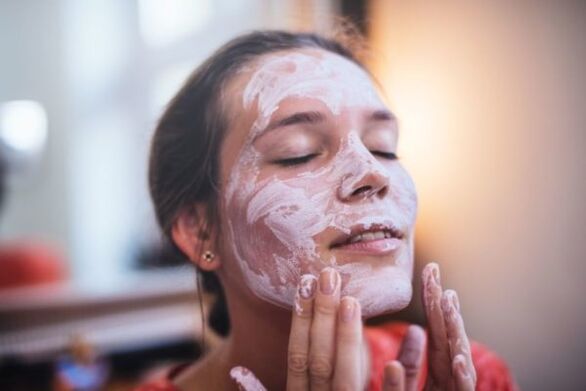
Treatment strategies
To successfully get rid of psoriasis, an integrated approach and strict compliance with medical recommendations are required. Commonly used treatments include:
- drug treatment;
- local impact;
- phototherapy;
- physical therapy;
- folk medicine.
It is also important to follow a special diet.
Treatment medicine
Pharmaceutical drugs are prescribed for the treatment of seborrheic psoriasis on the face in its advanced form. The following groups of drugs are commonly used:
- Antimicrobial drugs help reduce the intensity of psoriasis manifestations;
- a drug with succinic acid that normalizes cellular immunity and increases oxygen flow to tissues;
- antihistamines reduce itching and swelling;
- glucocorticosteroids;
- Sedatives are included in complex treatment to reduce stress. You can take extracts of valerian or motherwort;
- Folic acid helps normalize pigmentation and clear the skin.
Attention! Any medication must be taken strictly as prescribed by your doctor.
If the use of these drugs does not bring positive results, use Cyclosporine. It is prescribed in the most serious cases due to its many side effects.
Local agent
Ointments, creams and gels in the treatment of psoriasis help reduce inflammation, soften plaques, help relieve itching and disinfect damaged facial skin. The most effective remedies include ointments:
- Salicylic;
- Naphthalene;
- Sulfur-tar.
In extremely severe cases, a dermatologist may recommend topical hormonal medications. They have a number of contraindications, so their independent use is strictly prohibited.
Attention! You cannot hide psoriasis with cosmetic foundation! It will clog pores and block the access of oxygen to damaged tissues.
The effect of medicinal ointments is enhanced by using moisturizing and soothing preparations with shark oil or vitamin F. Physiotherapy will accelerate the healing process.
Physical therapy
In most cases, psoriasis patients will have to undergo a course of phototherapy - this restores the regenerative ability of tissues by exposing the facial skin to ultraviolet rays and stimulating them. stimulates the production of vitamin D. Depending on the symptoms and characteristics of the treatment course. of this disease, hardware operations such as:
- X-ray treatment;
- Ural Federal District;
- electric sleep;
- laser exposure;
- supersonic;
- magnetic field therapy.
These procedures directly affect the foci of inflammation, contributing to their localization and elimination. Improves the patient's general condition, including psychological. Traditional medicine recipes will be a good addition to conservative treatment.
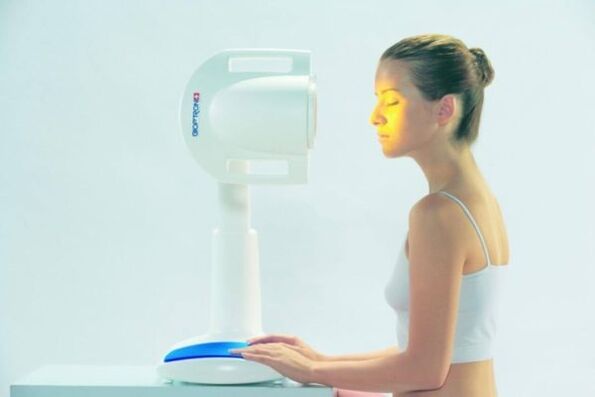
Folk remedies
Home remedies based on medicinal herbs and plants will help relieve the most unpleasant symptoms during the acute phase of psoriasis. Here are some popular recipes:
- Mix a spoonful of chamomile with 200 g of hot water and brew (about an hour). In the cooled and filtered solution, moisten a cotton cloth abundantly and apply it to your face for 30 minutes;
- Combine snake oil and birch tar in equal proportions. Apply the resulting mass evenly on the affected areas and leave for 20 minutes. Wash and lubricate face with moisturizer;
- Place a few aloe vera leaves in the refrigerator for a week, then take them out, chop them and apply them to your face for 30 minutes.
Products made from essential oils and sea salt are very helpful for psoriasis. In addition to facial care, proper and balanced nutrition plays a big role in eliminating psoriasis.

Diet
Nutrition for psoriasis should include all the substances necessary for the body. It is especially important to eat plenty of fiber. The diet must include adequate amounts of fruits, vegetables and dairy products. You cannot eat:
- sweet baked goods;
- chocolate;
- high-fat milk;
- nuts;
- any citrus fruit;
- spices and herbs;
- acoholic drink.
Dishes should not be fatty, fried, smoked or too spicy. Once a week it is recommended to organize fasting days "on kefir".
Prevent
People susceptible to psoriasis need to take simple precautions:
- wash with special products with a moisturizing effect;
- Wipe your face daily with a decoction based on chamomile or hops, especially in hot or frosty weather;
- Stop smoking;
- Avoid staying long in dusty or damp places;
- Spend more time in the sun.
See your dermatologist regularly to prevent the condition from getting worse. Psoriasis cannot be completely cured. However, by adhering to preventative measures and following medical recommendations, you can achieve steady remission and lead a fulfilling lifestyle.

























